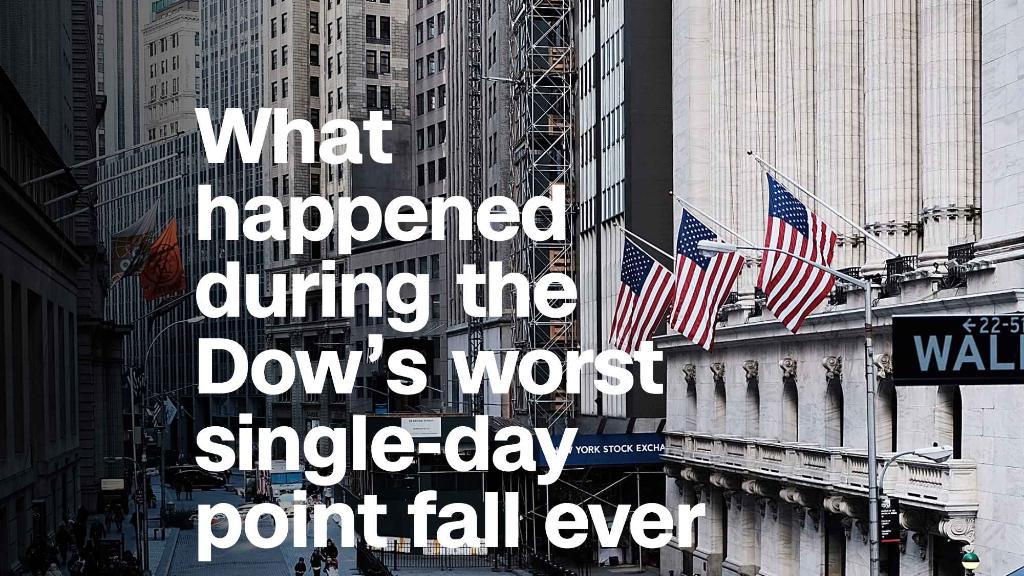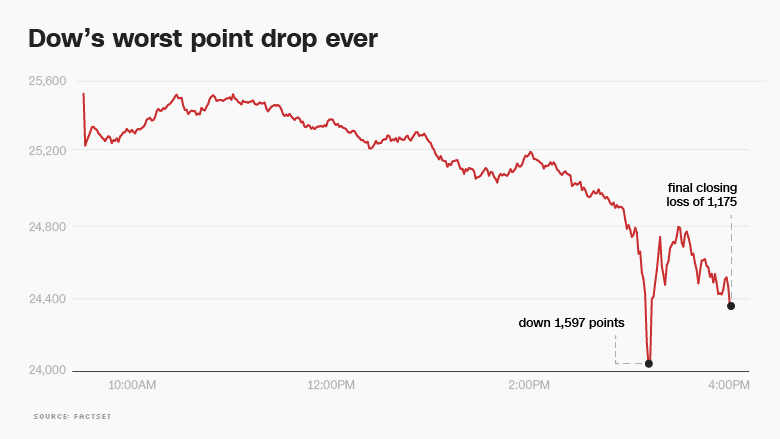
It was the scariest day on Wall Street in years.
Stocks went into free fall on Monday, and the Dow plunged almost 1,600 points -- easily the biggest point decline in history during a trading day.
Buyers charged back in and limited the damage, but at the closing bell the Dow was still down 1,175 points, by far its worst closing point decline on record.
The drop amounted to 4.6% -- the biggest decline since August 2011, during the European debt crisis. But it was nowhere close to the destruction on Black Monday in 1987 or the financial crisis of 2008. Still, for investors lulled to sleep by the steady upward climb since Election Day, it was alarming.
And the rout in U.S. markets continued to ripple around the globe. Japan's Nikkei index plunged 4% in Tuesday morning trading while the S&P/ASX 200 in Australia dropped 3%.
The White House said in a statement that President Trump was focused on "our long-term economic fundamentals, which remain exceptionally strong." The statement cited strengthening economic growth, low unemployment and increasing wages for workers.
The trouble in the market began early last week, when investors focused on a number of lingering concerns.
If the economy gets much stronger, it could touch off inflation, which has been mysteriously missing for the nine years of the post-crisis recovery. That could force the Federal Reserve to raise interest rates faster than planned.
"People are dealing with the shock of seeing real inflation for the first time in a while," said Bruce McCain, chief investment strategist at Key Private Bank.
The sell-off wiped out the Dow and S&P 500 gains for the year, and left the Nasdaq barely in positive territory for 2018.

Related: Market mayhem puts Trump in a tough spot
Investors have also been nervously watching the bond market, where yields have been creeping higher. As yields rise, bonds offer better returns, which makes them more attractive to investors compared with risky stocks.
Stocks sank throughout the day, then went off a cliff in the final hour of trading. The Dow was down 800 points at 3 p.m. Within minutes, it was down 900, 1,000 -- and then 1,500 points. At its low, the Dow was down 1,597 points, before buyers rushed in and limited the decline.
The Nasdaq slumped more than 2%, quickly turned positive, then sank again. It finished down almost 4%. The S&P 500, a broader gauge of the market than the Dow, declined more than 4%.
The plunge pushed stocks closer to what's called a correction, or a 10% decline from their most recent high point. The S&P 500 is down almost 8% from its all-time high.
"The stock market is throwing a tantrum," said Andres Garcia-Amaya, CEO of wealth management firm Zoe Financial.
"Take a deep breath," said Garcia-Amaya. "I know it's been a while since we had a day like today, but nothing has really changed from a fundamental standpoint."
The market started 2018 with a bang, but last week was the worst on Wall Street in two years. The selling gathered steam on Friday when the Dow plunged 666 points, or 2.5%, at the time its worst day since the Brexit mayhem of June 2016. Nearly $1 trillion of market value was erased from the S&P 500 last week.
"You had a market that was overbought and ripe for something to undermine its tranquility," said Mark Luschini, chief investment strategist at Janney Capital.
The VIX volatility index, a measure of market turbulence, skyrocketed a record 116% on Monday to the highest level since August 24, 2015, the last time the Dow plunged 1,000 points in a day. The spike signifies how calm Wall Street had been -- and how unprepared the markets were for trouble.
CNNMoney's Fear & Greed Index is flashing "fear," underlining a major shift in market sentiment from a week ago when it was sitting in "extreme greed."
The Russell 2000, an index of smaller stocks that have heavy exposure to the U.S. economy, turned negative for 2018 for the first time.
"Valuations got stretched and that led to a cascading effect today," said Sam Stovall, chief investment strategist at CFRA Research. "The market has to correct itself -- a resetting of the dials -- before this bull market can continue."
Related: Good news for Main Street is freaking out Wall Street
Investors' main concern is the sell-off in the bond market. The 10-year Treasury yield, which moves opposite price, spiked to a four-year high of 2.85% on Friday. It's a dramatic swing from 2.4% at the start of 2018. Higher yields could make normally boring bonds look more attractive when compared with risky stocks.
The U.S. economy is healthy. Friday's jobs report showed that wages grew at the fastest pace since 2009. That's a welcome shift by workers who have been dealing with anemic raises for years.
Has your paycheck gotten bigger thanks to the new tax bill? Will it make a difference? If so, what will you do with the extra money? Tell us about it here.
However, Wall Street is starting to get worried that the "goldilocks" environment of slow growth and mysteriously low inflation may be ending. Besides the fear of faster inflation and interest-rate increases, more robust wage gains could eat into record-high corporate profits.
No matter the cause, the stock market was long overdue to take a breather. Before Friday, the S&P 500 had gone the longest stretch ever without a 3% pullback. Now the S&P 500's record-long period without a 5% retreat is in jeopardy.
Related: This is why the Dow is plunging
While they can be scary, market pullbacks prevent stocks from overheating and give investors who were stuck on the sideline a chance to get in. Janet Yellen, who just stepped down as Fed chief, told PBS on Friday that she still believes "asset valuations generally are elevated."
Despite the recent turmoil, the Dow remains up almost 40% since President Trump's election. The robust performance has been driven by strong corporate profits, healthy economic growth and excitement about the Republican tax cut for businesses.
Analysts at Bespoke Investment Group urged calm.
"Take a deep breath," the firm wrote in a research note on Friday. "For those investors that may have forgotten, this is what a market decline feels like."
The question is whether the market retreat deepens or whether investors buy at the dip, a mentality that has supported stocks for months.
"The fundamentals of the economy remain quite strong," said Janney's Luchini. "It's hard to make the case for why we should be down more than 10% -- unless we encounter negative economic news."
Key Bank's McCain agrees. "We believe this is not the beginning of the end and a tilt towards a bear market. It's premature for that," he said.
Wells Fargo suffered some of the worst of the selling on Monday. The No. 2 U.S. bank plunged 9% after unprecedented sanctions were handed down by the Fed late Friday.
--CNN's Liz Landers contributed to this report.


